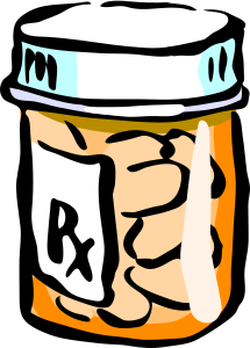Humans make mistakes in thinking due to how the brain handles information. The name for these errors is cognitive bias. Research has shown that learning about cognitive biases can help you make better decisions. Better decisions will lead to better healthcare, faster healing, and a lowered risk of future clots.
Recency effect
Have you found yourself looking back into the days and weeks before your clot to try to figure out what caused it? Be careful, you may find your brain suffering from the recency effect. Our brains tend to look at how close together two things happened in time. The more recently something happened the more likely we are to think that it was the cause. Maybe you ran a marathon, started a new medication, or took a supplement in the days leading up to your blood clot. While these might be the cause of your clot it is also possible that genetics, pregnancy, or other long term risk factors were the cause of your clot. It is also possible that your clot was caused by multiple risk factors rather than a solitary event. It is important for you and your medical tem to evaluate all of your risks rather than the ones that may have just happened.
Confirmation bias
Did you jump on the Internet to see what caused your clot? Be careful, we tend to favor information that supports what we already believe. Humans have a difficult time believing evidence that tells them what they think is wrong. Let’s look at an example. Sally has a blood clot and her doctor puts her on warfarin, an anticoagulant. Sally knows that warfarin is also used as rat poison so she is very uncomfortable with this medication. She goes to the Internet to read about warfarin. She reads five articles that state that warfarin is safe and one article that states warfarin is dangerous. Sally favors the one article that states that warfarin is dangerous because it supports what she already believed. She goes to her doctor and asks to switch medications. The human brain doesn’t like to be wrong. When doing research it is a good idea to try to prove yourself wrong rather than right.
Faulty generalization
Looking at other people’s experiences can be comforting but it can also cause errors in thinking. Human brains tend to over estimate how many times something happens. We often think that if we meet one person that had something happen this must be true for everyone. Here are some examples.
Sam’s mother died of a brain bleed while taking a newer anticoagulant. Bob’s mother takes warfarin and has no side effects. This must mean that warfarin is safer. In reality some of the newer anticoagulants have a much lower risk of brain bleeds. In this example I don’t pay attention to the fact that I need to look at thousands if not millions of examples to know which medication is safer. One example does not tell me how other people overall react to a medication. This is why we need thousands of people in drug studies.
Mary had a blood clot while on birth control. It must be very dangerous. Again I am looking at just one person. I did not consider the millions of people who didn’t have a clot on birth control. Pregnancy is a larger risk factor than birth control. I missed that information though because I only focused on my friend Mary.
To overcome this error in thinking make sure to read studies that look at thousands of people. Ask your doctor for advice about medications. Doctors are trained to read medical papers and understand risk factors. It is a good idea to ask your doctor why he or she favors a treatment or preventative measure. Feel free to ask for the research so that you can be confident that your healthcare decision is based on the full picture rather than just one or two people. Be careful on support groups. They are a great resource but make sure that you aren’t taking a few people’s experiences and favoring them over well researched information. Just because it happened to one person doesn't mean that it will happen to you.
Negativity bias
We tend to pay more attention to bad news versus good news. When we see a lawyer add on television for malpractice we believe that this is happening everywhere and we can’t trust the medical community. We hear about blood clots or bleeds being associated with treatments and we don’t see the millions of people who benefit from these treatments. We hear about people who struggle to recovery from a pulmonary embolism and don’t see those who heal in two weeks. We see our own misery and don’t see that we can ever heal. I recommend that you try to intentionally focus on the positives. Keep a list of five good things that happen a day. Chart your progress that you make in recovery on a daily or weekly basis. Pay attention to those people in support groups who are thriving. These will lighten your heart and help you to avoid the negativity bias.
Wrong authority
We don’t do a good job knowing who to trust. We may find advertisements and peers better sources of information than our doctors. Make sure that you use your medical team as your main source of information. It can be difficult to know which articles online can be trusted. If you want to read more on a topic you can visit a library and ask the librarian for help in finding information from reliable sources. If you happen to have a medical school near you then take advantage of it! It will have a medical library with a trained medical librarian.
If you struggle with trusting your doctor try these ideas:
- Ask questions until you know why your doctor feels a certain diagnosis or treatment is correct
- Ask why NOT the alternate diagnosis or treatment
- Seek second opinions from other doctors
- Ask your pharmacist
- Find a support group or questions and answer service that is staffed by doctors
- Ask different types of doctors and have a variety of doctors on your team (OBGYN, GP, internist, hematologist, radiologist, pulmonologist)
- Consult sites that are written for doctors by professional organizations
- Use sites that end in .gov or .edu for your research
- Get a doctor that you trust
How to overcome biases in thought
- Look for research that disproves your belief and seriously consider it.
- Don’t take one person’s story and use it as the basis for your treatment. Use professional research and the opinion of your medical treatment team as the basis of your treatment decisions.
- Make sure to take note of the positives as well as the negatives.
- Don’t panic when you hear lawyer ads. You can use them as a sign you should research something more. Do not assume that because there is a malpractice ad that there really is a huge problem with a treatment.
- Look at research statistics not individual experiences.
- Use reliable sources. Many end in .edu or .gov. A librarian can also point you towards reliable places to get information.
- Find professional organizations that deal in clots. The Clot Spot has a great list of these in the resources section.
- Don’t panic!


 RSS Feed
RSS Feed

